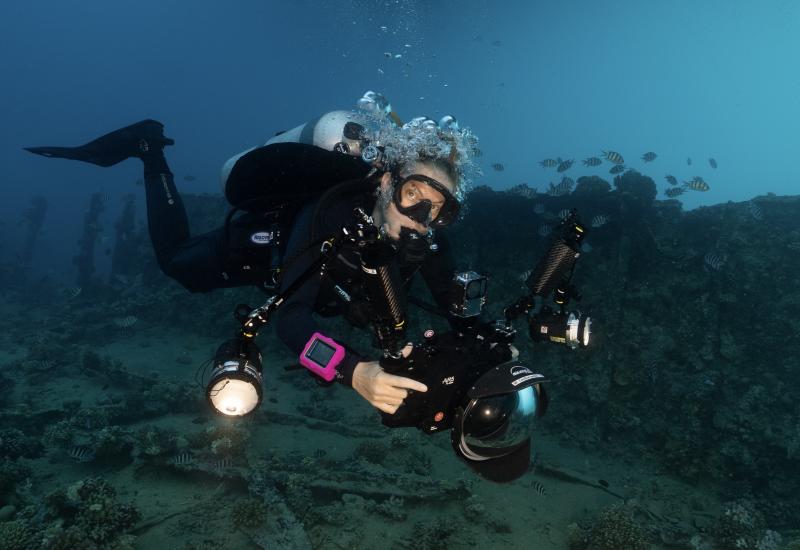Think Big: How To Put Grouper in the Spotlight

Alex MustardGEAR Nikon D850 with 8-15mm f/3.5-4.5 lens; SETTINGS f/13; 1/100; ISO 200
Groupers have been a favorite fish since the pioneering days of diving. Widespread in the tropics and subtropics, they are slow-moving, curious and intelligent, and many are highly colored. Their big eyes and rubbery lips give them a cartoonish charisma. Groupers are long-lived and can become so infatuated with divers that they follow them closely— much to the enjoyment of any shooter. Such big personalities deserve the best photographic treatment.
Dedicated grouper dives take place in locations such as Cod Hole on the Great Barrier Reef and Grouper City in Lavezzi between the Mediterranean islands of Sardinia and Corsica. In locations with friendly groupers, close-focus wide-angle techniques should be your go-to. Use a small dome port to maximize subject magnification and make it easier to avoid shading on the subject. Pull strobes in tight to the housing, but still behind the port, to light the fish when it is right on the dome.
Getting the most out of the action on grouper dives requires preparation. Think about the types of shots you want beforehand and then methodically work through the list underwater. The two images to prioritize are portraits to show off character and diver shots to reveal the size of the fish and the interaction. In both cases, you want the grouper close to the camera, bossing the composition. When you include a diver in the background, the framing makes the grouper look supersized.
On busy dives, it’s easy to forget about the details of technique and composition. For example, when shooting groupers with people, make sure to close the aperture to keep both fish and diver sharp. In all photos of a diver with marine life, it is important that the model’s line of sight connects with the subject. If your buddy is looking at the grouper in the frame, the subject is reemphasized, if they are looking out of frame, then the composition is weak. I often shoot these images from the hip, so I can look over the top of the camera to watch the model’s eyes, only firing at the opportune moment. Looking through the viewfinder, a diver’s eyes are often too small to be able to see clearly.
Coral reefs should always support large numbers of mesopredators, such as groupers, but in many places, they are rare because of overfishing. If you don’t see many large groupers, it’s a sign of a degraded ecosystem, even if the reefs are pretty. For this reason, remote protected areas often have the most groupers.
I prefer to photograph groupers as the focal point for a wide-angle reef shot. Coral groupers, red with blue spots, are very common and also one of the most beautiful reef fish. They are found on reefs throughout the Indo-Pacific but are particularly abundant in the Red Sea, western Thailand and Raja Ampat. When you can include them in a wide-angle scenic image, they supercharge the composition.
Many scenic wide-angle pictures lack fish because, to get them right, the photographer must stay there for a while fiddling with settings and lighting. Letting the fish drift away. The solution is, having first refined the lighting, to swim away for a minute and let the fish return, then shoot again. Coral groupers are territorial and have favored spots to lurk. If you see them hovering somewhere once, they will likely return if you give them space. Sadly, groupers are not common everywhere these days. For many people, grouper is particularly tasty on the barbecue. We should be thankful when we dive in places that still have groupers and celebrate these characterful fish as superstars of the reef.
BEHIND THE SHOT
When used to people, groupers will commonly follow divers, especially if they avoid eye contact. They love to stay in your blind spot, appearing suddenly alongside your mask. When a grouper is shadowing you, swim ahead and set up a shot for the fish to swim into the frame and complete the composition. This goliath grouper in Cuba was friendly but didn’t like me approaching it, so I swam away and looked down through my camera and waited for the big fish to come in close. Goliath grouper don’t have the most expressive faces, but the forced perspective of the fisheye lens I used here creates a characterful portrait.
Related Reading: Say Cheese! How to Orchestrate Stunning Fish Portraits










